The overwhelming climate damage from Canadian cars comes from burning the gasoline to move them around. Over the full life cycle of Canadian gasoline cars and electric cars, the 70 tonnes of CO2 from burning gasoline absolutely crushes everything else.
To help visualize the gargantuan scale of gasoline car emissions — and how much less climate damage an electric car driven in Canada causes — I’ve created a series of charts.
Let’s start by looking at the most consequential stage in a car’s life cycle: the fuel.
Gasoline versus made-in-Canada electricity
Electricity made in Canada is much cleaner to drive on than gasoline. My first chart shows the relative climate emissions from fuelling our cars with each. (Note: In this article, I use the term « gasoline » to refer to both gasoline and diesel road fuels. They have similar CO2 intensities. For more on this and all the other nerdy carbon details used in this article, see the endnotes.)
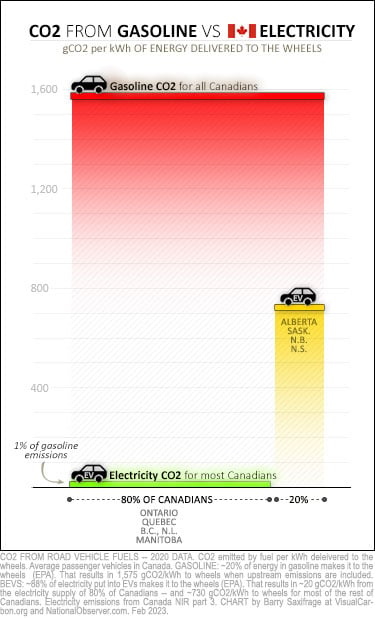
As the top red line on the chart shows, burning gasoline creates sky-high emissions.
In fact, gasoline is even climate-dirtier than coal. Burning gasoline in a car emits more CO2 per unit of energy than burning coal in a power plant. And in Canada, our cars also dump twice as much total CO2 into the air each year than all our coal power plants.
Fortunately, we have a much cleaner and safer fuel: our made-in-Canada electricity.
Eighty per cent of Canadians live in provinces with super-clean electricity — Ontario, Quebec, B.C., Manitoba and Newfoundland and Labrador. Driving on their electricity nearly eliminates the climate pollution from fuelling a car. That’s shown by the green bar at the bottom of the chart.
And even in our provinces with the most carbon-intensive electricity — like Alberta, Saskatchewan and Nova Scotia — driving on electricity is only half as climate polluting as gasoline. This is shown by the yellow bar. And that yellow bar keeps going down. It’s already a third lower than in 2000 and is on track to keep falling.
Not only does burning gasoline create far more climate damage, it also makes people sick. The noxious chemical smog produced by burning gasoline and diesel is a key cause of illness and early death in Canada and worldwide. Even small amounts of tailpipe emissions have big health impacts. For example, a recent California study found that asthma-related emergency room visits declined in areas after only a tiny percentage of cars had switched from gasoline to electric.
And a third big strike against gasoline is that it costs Canadian drivers far more than electricity. How much more? Gasoline currently costs around $1.50 per litre. Charging an electric car at home costs around 25 cents per litre-equivalent for most Canadians. At those prices, gasoline will end up costing $30,000 more than electricity over the lifespan of an average new car.
So far we’ve just compared the fuel side of things. Next, let’s expand the focus to see the full life cycle emissions, which include the cars themselves.
Over the full life cycle of Canadian gasoline cars and electric cars, the 70 tonnes of CO2 from burning gasoline absolutely crushes everything else — including our climate hopes. But other nations have found ways to rein it in. @bsaxifrage writes
‘What about the batteries?’
The most common question I get when discussing gasoline’s huge climate impacts is: « But what about the batteries for electric cars? »
So, to shed some light on this perennial question, I dug into a detailed life cycle analysis of gasoline cars and electric cars by the International Council on Clean Transportation (ICCT). And to make it Canada-specific, I used the electricity emissions from our provinces. My next chart shows the result.
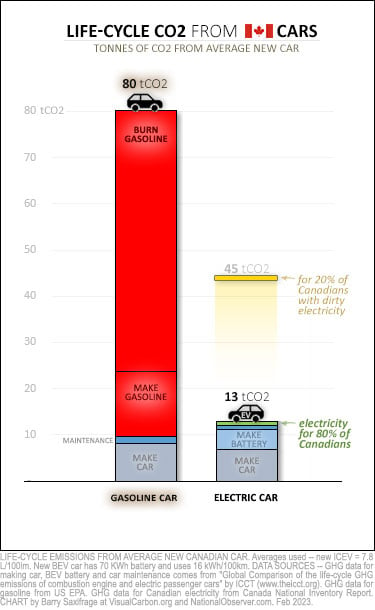
That towering bar on the left is the life cycle emissions for the average new gasoline car in Canada. It totals around 80 tonnes of climate pollution (tCO2) per car.
As the red part shows, almost all that climate damage is caused by the gasoline — a crushing 70-tonne climate hammer per car. Only a tenth of a gasoline car’s life cycle emissions come from making the car itself. If that seems surprising, consider that the gasoline that has to be burned weighs 10 times more than the car itself.
Luckily, Canadians looking to buy a new car can choose one that runs on electricity instead. As the chart’s right-hand bar shows, electric cars in Canada create far fewer life cycle emissions.
Making a gasoline car is currently a bit less climate-polluting than making an electric car. Around 2 tCO2 less. But this small advantage gets wiped out many times over by the extra emissions from fuelling the car.
For example, in our clean electricity provinces, the fuel needed to drive an electric car will emit only one tonne of CO2. That’s shown by the tiny green bar on the chart. In these provinces, the life cycle emissions for an electric car add up to around 13 tCO2.
And even in Canada’s dirty electricity provinces, electric cars result in only half the climate impact of gasoline cars. And as their electricity keeps getting cleaner, all their electric cars do, too.
The clear takeaway from this life cycle analysis is that gasoline cars are hugely climate-polluting. If we want a shot at a livable climate future, then we need to stop filling our roads and driveways with new 70-tonne climate hammers.
The good news is that we have cleaner electric options. The bad news is, well …
Canadians keep buying burnermobiles
Unfortunately, a decade of having electric cars available in Canada hasn’t slowed the rising tide of gasoline burners.
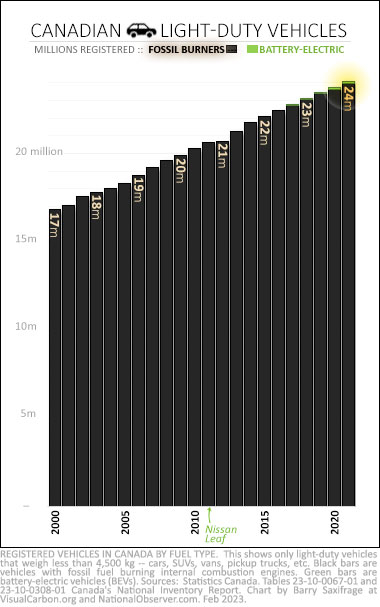
Here’s a chart showing the latest vehicle registration numbers from Statistics Canada.
The height of each bar on the chart indicates the number of light-duty vehicles (cars, SUVs, vans, and pickup trucks) registered each year in Canada.
The black bars are vehicles that burn gasoline. Their numbers have marched upwards like clockwork — from 17 million two decades ago to more than 24 million last year. It’s a startlingly, relentless rise that’s adding another million fossil burners to our roads every three years.
That’s a lot of 70-tonne climate hammers.
Where are all the electric cars? They’re shown on the chart by those tiny green bars at the top. Yeah, not many. They’re barely visible at this scale.
In Canada, electric cars are a thin green frosting on top of an ever-expanding fleet of burnermobiles. For every new electric car added to our roads over the last five years, we’ve added 10 more gasoline cars.
Ten steps backwards isn’t climate progress.
More tailpipes. More emissions
Unsurprisingly, adding millions more gasoline burners has also led to millions more tonnes of climate pollution pouring out the tailpipes.
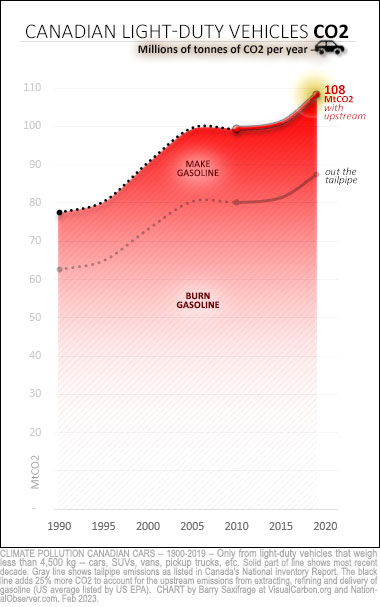
My next chart tracks gasoline emissions from Canadian cars since 1990.
The CO2 coming out of tailpipes is shown by the lower grey line. The full life cycle emissions for that gasoline are shown by the upper line.
Take a look at the trend since 2010. That’s been the decade of rising electric car options and sales. Have cleaner options led to falling gasoline emissions in Canada?
No. Just the opposite.
Gasoline emissions have taken off, rocketing past the 100-million-tonne mark.
Canada’s single biggest source of climate pollution is the making and burning of gasoline. Having that emissions curve surging upwards obviously isn’t climate progress.
It’s Category 5 climate failure.
What can we do in Canada?
Is there anything we can do to bend our emissions curve rapidly downward toward climate safety?
Yep. Plenty.
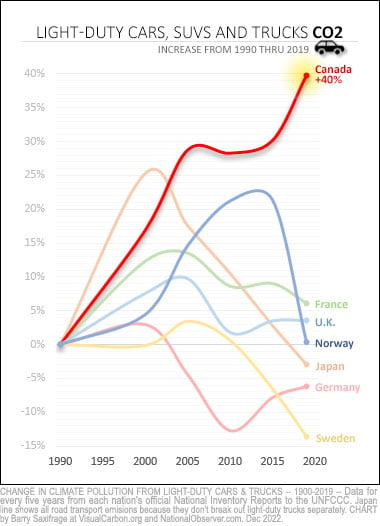
It turns out that many of our peer nations have found ways to reduce the climate pollution from their cars.
The policies that have worked for them are based on the « polluter pays » principle. These policies include higher taxes on gasoline and adding CO2-weighted fees on gas guzzlers. We can adopt policies like these that have worked so well for them.
Here are just two examples.
Our Commonwealth peers in the United Kingdom (U.K.) successfully reduced their car emissions by doubling their gasoline taxes. The Conservative government of John Major started that decades ago with the express goal of reining in their climate emissions. Today, the U.K. taxes gasoline three times higher than Canada does — their gas tax is the equivalent of $560 per tonne of CO2 emitted.
A second example is Norway. They’ve led the world in the race to eliminate the sale of new gasoline-burning cars. And as the chart above shows, their success has resulted in a plunging drop in their car emissions.
Nearly everything I read in Canada about Norway’s rapid transition away from gasoline cars gets the policy part wrong. The common assumption here is that Norway did it by offering great incentives for buying cleaner electric cars (carrots). But the key to Norway’s success has been policies that raise the cost of the dirtier gasoline cars (sticks).
Their most effective single policy has been a « polluter pays » tax added to new cars. Specifically, they calculate the purchase tax for new cars based on car weight, CO2 emissions and NOx emissions. This can nearly double the cost of buying a polluting gas guzzler. Imagine Canada bringing in an 80 per cent sales tax on big, new gas-guzzling SUVs and you’ve got the basic idea.
And a second « polluter pays » policy tag teams with that: Norway taxes gasoline even higher than the U.K. — at the equivalent of $600 per tonne of CO2 emitted.
These two policies can easily add $50,000 or more to the cost of the kinds of new gas guzzlers Canadians buy.
So, it’s not surprising that Norwegians stopped buying new gasoline cars. Their policies made them too expensive. Canadians would do the same if we adopted similar policies.
And, critically, Norway’s policies have also changed the incentives for legacy automakers. If automakers want to sell cars in Norway, they have to offer cars that Norwegians can afford — electric ones. And, unsurprisingly, car companies fill their showrooms in Norway with electric cars. In fact, many legacy makers have completely stopped offering gasoline cars there.
In contrast, Canada’s car emissions are rocketing in the opposite direction — up, up, up. That’s because we’ve avoided « polluter pays » policies. Instead, our gasoline taxes remain ultra-low compared to most of our peers. And we lack any effective « polluter pays » fees on buying new gas guzzlers. The result is that new gas guzzlers remain as affordable as ever in Canada. And so Canadians keep buying them.
And, to make matters worse in Canada, legacy automakers have a huge financial incentive to prioritize selling gasoline cars here, while dragging their feet on offering electric cars. That’s because legacy car companies make the most profit selling their biggest gas-guzzling SUVs and pickup trucks. They are desperate to sell them somewhere in the world.
Canada’s ever-growing horde of burnermobiles and soaring tailpipe emissions are exactly what you get when polluters don’t have to pay.
—————————–
Endnotes:
CANADIAN ELECTRICITY
In this article, I grouped provincial electricity into two groups for simplicity.
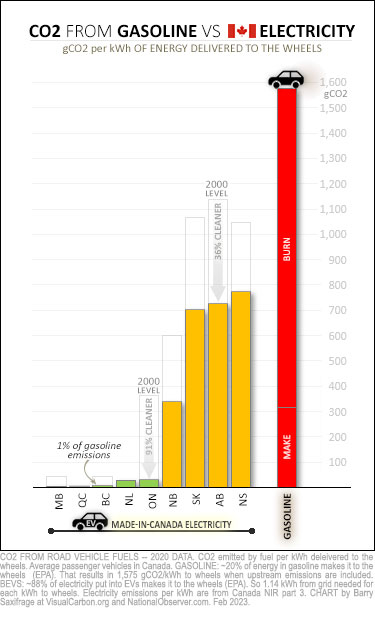
For those interested in a breakdown by province, here’s a chart showing the details. The data source for provincial electricity emissions is Canada’s National Inventory Report (Part 3).
The height of each bar shows grams of CO2 per kWh delivered to the wheels.
The red bar is gasoline. This is essentially the same in all provinces.
The five green bars on the left are the five provinces I grouped together as having super-clean electricity. Eighty per cent of Canadians live in these provinces.
The next four provinces, shown by orange bars, have much dirtier electricity. In the article, I grouped them together using a population-weighted average that worked out to be very similar to Alberta’s electricity of just over 700 gCO2 per kWh to wheels.
This chart also lets you see how much cleaner each province’s electricity has become since 2000. For example, Alberta’s electricity is now 36 per cent cleaner than in 2000. And Ontario’s electricity is 91 per cent cleaner. Policies already on the books will continue this trend towards cleaner electricity as coal power is slated to be replaced primarily by wind. That means that an electric car bought today will be fuelled by increasingly cleaner electricity over its lifespan.
HOW TO COMPARE GASOLINE TO ELECTRICITY
In this article, and in that chart just above, I compared gasoline to electricity in terms of the CO2 emitted to deliver the same amount of energy to the wheels. I like this metric because it allows direct comparisons of fuels that are independent of any specific model or make of car. For those interested in how I calculated this metric, here are the details.
For gasoline cars. The U.S. Environmental Protection Agency (EPA) says ~20 per cent of the energy in gasoline ends up turning the wheels. The rest is lost in waste heat and friction. So, to deliver each kWh of energy to the wheels, drivers need to fill the tank with 5 kWh worth of gasoline. The direct emissions from burning 5 kWh worth of gasoline are 1,260 gCO2. The full life cycle emissions for gasoline are ~ 25 per cent higher (EPA). Adding those increases gasoline’s life cycle total to 1,577 gCO2 per kWh of energy to the wheels.
For electric cars. Battery electric cars are far more energy efficient. The EPA says that ~88 per cent of the electricity put into an electric car makes it to the wheels. So, to deliver each kWh of energy to the wheels requires charging the car with 1.14 kWh of electricity from the grid. The emissions from that depend on the electricity supply. For example, Quebec’s electricity emits 2 gCO2 per kWh. So, 1.14 kWh of Quebec electricity results in 2.28 gCO2 per kWh of energy to the wheels — 500 times less climate polluting than gasoline.
DETAILS ON THE AVERAGE CAR
If you are interested in details about the « average car, » here are some key metrics used by the ICCT in its life cycle analysis. The ICCT data I used in this article were specifically for the average new sedan-style car sold in the United States (note: key differences with the SUVs and pickup truck segment are discussed further down). Using U.S. government data, the ICCT determined that the average new gasoline car there consumes 7.8 L per 100 kilometres. Canadians buy slightly more gas-guzzling cars than Americans do, but I didn’t adjust for that. For new electric sedan-style cars, the ICCT found that the sales-weighted average battery size is 70 kWh. For U.S. cars, it found that the average lifespan is 314,000 kilometres. They assumed new electric cars will last for a similar number of kilometers as new gasoline cars — although it also noted that new electric car batteries are built to last several times longer (see discussion on batteries below for more details).
BATTERY EMISSIONS ARE LIKELY OVERSTATED
The ICCT life cycle analysis listed the emissions for making the average new electric car battery at around four tonnes of CO2. But the study also pointed out that a broader life cycle accounting would shift a big chunk of these battery emissions from the electric car phase to the post-car, second-use phase as stationary grid storage batteries. That’s because they say that many of the current generation of electric car batteries are built to last 600,000 to 1,200,000 kilometres. So many batteries have a long useful life remaining even when the car itself wears out. These batteries are getting reused as stationary batteries to store electricity. This second phase in their life cycle reduces fossil fuel emissions further by capturing excess renewable electricity generation (example: more sun and wind power being generated at a given moment than the grid needs). This, in turn, reduces the amount of fossil fuel burning needed to generate electricity. The combination of this battery reuse, together with future recycling of the battery materials, is expected to reduce the emissions from building electric cars to below those from building gasoline cars.
SUVs & PICKUPs
The life cycle data I used in the article was for sedan-style passenger cars. The ICCT also analyzed the average new SUV/pickup category separately. Not surprisingly, life cycle emissions were higher in all stages. But once again, gasoline emissions overwhelmed everything else. Gasoline emissions for the average new SUV/pickup were 18 tCO2 higher than for sedan-style cars — resulting in 88-tonne climate hammers per car. In contrast, the emissions from making the bigger batteries for the electric SUV category rose by one tonne of CO2. All in all, the emissions gap between gasoline and electric cars was even larger for SUVs than for sedan-style cars.
DIESEL VERSUS GASOLINE
In the article, I only discussed « gasoline » for simplicity and because 95 per cent of passenger vehicles in Canada burn gasoline. Diesel cars have a similar CO2 intensity as gasoline cars. It is often stated that diesel engines can be a bit less CO2-intensive than gasoline engines. But studies of real-world driving show most or all this benefit gets lost before getting to the wheels. For example, a study by the ICCT concluded: « a modern gasoline vehicle can have the same or even lower CO2 emissions than a comparable diesel version. » One big reason is that diesel vehicles require a lot of extra energy to filter out the higher levels of NOx gases. Trying to avoid paying that energy penalty was the motivation behind the Dieselgate emissions cheating scandal by VW and others a few years ago. In addition, diesel vehicles are often heavier and have more powerful engines, further eroding the real-world efficiency for them.











